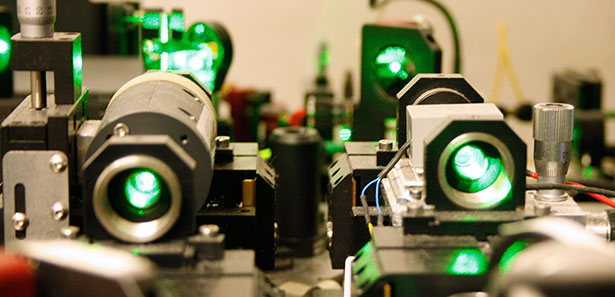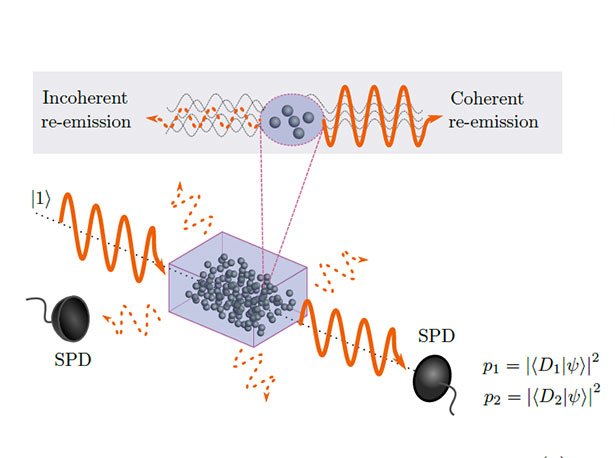Detecting quantum superpositions
Quantum-physical coupling of large quantities becomes detectable
Coupled atoms: Physicists have succeeded in interlacing 16 million atoms in a crystal - and this quantum-physical coupling can also be detected. They developed a way to determine the entanglement of the atoms from the outside without losing the coupling. The exciting thing about this is that such crystals of entangled atoms can be used as amplifiers in future quantum networks.

This laser system produced the single photons, which caused the atoms in the crystal to become entangled. © Université de GenèveOne of the features in the realm of quantum physics is the phenomenon of entanglement: the states of two particles are coupled to each other in such a way that the state change of the one automatically causes that of the partner - even if both particles are hundreds of kilometers apart. Even in orbit, this quantum-physical coupling is possible. The great advantage of this is that any unauthorized access to the information encoded in these particles can be recognized immediately.
The problem is the proof
However, entanglement is not limited to two photons or atoms: Purely theoretically, huge amounts of particles can be coupled quantum-physically to one another. Even with macroscopically visible objects this should be possible. Practically, however, this research has so far only been successful with hundreds of ions and up to 2,900 atoms.
The problem: >To achieve the interlacing of large systems is usually much easier than to prove it, explains Florian Fröwis and his colleagues from the University of Geneva. In order to directly observe the coupling between several million atoms, one would have to collect and analyze enormous amounts of data.
Cold Crystal and indicator-photon
However, Fröwis and his colleagues have succeeded in circumventing this problem by means of a trick. For their experiment, they used a crystal of ytterbium orthosilicate (Y2SiO5) doped with neodymium atoms. They cooled this crystal down to 270 degrees below zero, and then irradiated it with a photon. When this photon passes through the crystal, it dissipates an entanglement with its several million atoms - so the theory.

The characteristics of the radiated photon reveal that the atoms are entangled in the crystal. © Fröwis et al / Nature Communications, CC-by-sa 4.0In order to prove this, the researchers concentrated on what the crystal yields again: if it only emits stray light, its atoms can not be clipped, as they explain. However, it is different if the crystal emits a photon having the same characteristics as the original trigger photon. The quantum physics presupposes that this effect can only occur when the atoms in the crystal have been entangled by the irradiated photon.
16 million atoms entangled - at least
And indeed: In their experiment, the physicists registered 50 nanoseconds after the irradiation of the photon the predicted reaction. The excited entangled atoms in the crystal sent out a "copy" of this photon. From their measurements, the researchers conclude that at least 16 million atoms must have been cross-linked in the crystal. Immediately after absorption of the trigger photon, it could even have been a billion.
This demonstrates that even large entanglement depths are verifiable experimentally, Fröwis and colleagues say. This even applies to systems with more than ten billion atoms and low reemission efficiencies.
The principle of its detection method is also applicable over a wide range of physical systems.
This is particularly interesting because such crystals with entangled atoms could serve as relays in future quantum networks. The coupled emission of the atoms amplifies the signal of the irradiated quantum information, as the researchers explain. As a result, the range of quantum signals could be increased, for example, in glass fiber networks.
Source: Université de Genève

I am happy to follow you.
This post has received a 1.56 % upvote from @drotto thanks to: @banjo.
img credz: pixabay.com
Nice, you got a 9.0% @minnowbooster upgoat, thanks to @n3bul4
Want a boost? Minnowbooster's got your back!
The @OriginalWorks bot has determined this post by @n3bul4 to be original material and upvoted it!
To call @OriginalWorks, simply reply to any post with @originalworks or !originalworks in your message!
For more information, Click Here!
Special thanks to @reggaemuffin for being a supporter! Vote him as a witness to help make Steemit a better place!
This post has received a 4.57 % upvote from @booster thanks to: @n3bul4.